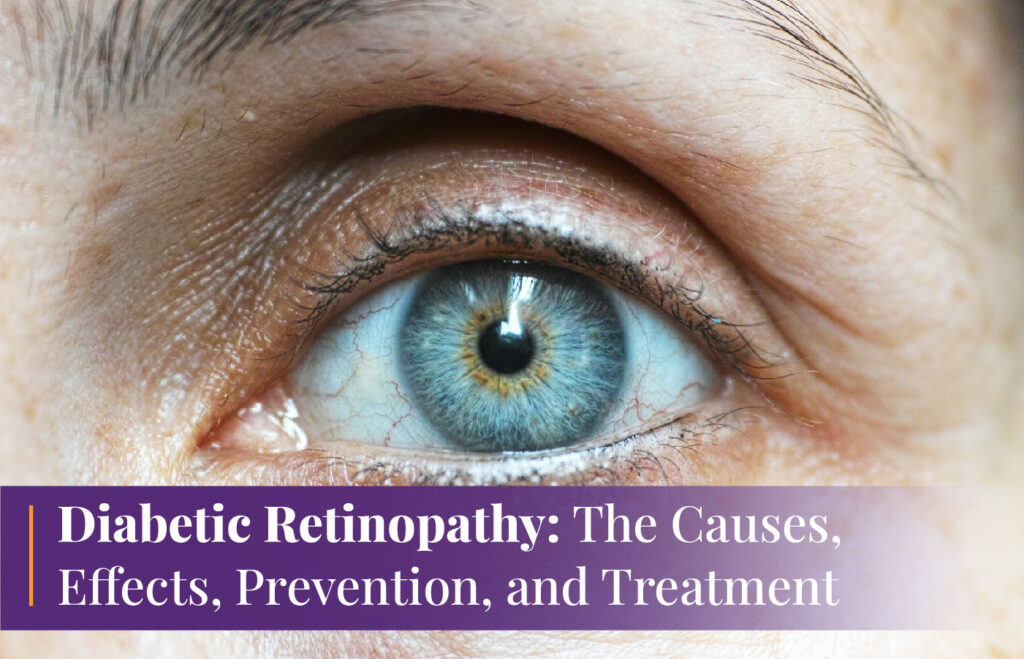Diabetic Retinopathy: The Causes, Effects, Prevention and Treatment

Introduction
Diabetic retinopathy is a severe eye complication that can afflict people with diabetes. Elevated blood sugar levels damage the blood vessels in the retina, which is the light-sensitive tissue situated at the back of the eye. Failure to treat this condition may result in visual impairment or even total blindness. One of the eye diseases that can result from diabetes is diabetic retinopathy.
This blog will discuss the nature of diabetic retinopathy, its causes, prevention, treatment, and impact on patients’ lives. Furthermore, we will address the post-treatment care necessary to preserve eye health.
What is diabetic retinopathy?
Diabetic retinopathy is a prevalent complication of both type 1 and type 2 diabetes. As blood sugar levels remain elevated for an extended period, the small blood vessels that transport nutrients and oxygen to the retina may become compromised and harmed. Visibility issues may ensue due to the enlargement, leakage, or occlusion of the impaired blood vessels. Read more about various retinal conditions and the best retinal medical services.
What is the impact of diabetic retinopathy on patients?
Individuals who develop diabetic retinopathy may experience severe consequences. There may be both physical and emotional consequences.
Vision Impairment: In the early stages, a person may not have any symptoms. However, as the disease worsens, they may start to have trouble seeing at night, see floaters (small dark spots or specks) in their field of vision, or have difficulty seeing at night.
Decreased Quality of Life: Vision impairment can complicate routine activities, including reading, driving, and face recognition. Patients may also experience feelings of isolation and reliance on others for support.
Peril of Vision Impairment: Untreated diabetic retinopathy may result in permanent blindness in extreme cases. Hence, it is necessary to understand the criticality of timely identification and intervention.
Understanding the Causes:
Diabetic retinopathy is mainly caused by uncontrolled diabetes and persistently elevated blood glucose levels.
Primarily, two varieties of diabetic retinopathy exist:
Vascular damage in the retina, which can cause blood or fluid to leak out, is a symptom of non-proliferative diabetic retinopathy (NPDR) in its early stages. Initially, some patients with NPDR may not exhibit any symptoms.
Proliferative diabetic retinopathy (PDR) is the development of new, sensitive blood vessels in the retina as the disease advances. These blood vessels can rupture into the eye, resulting in additional vision impairment.
Preventive measures:
Effective diabetes management is the initial step, and the following are the essential preventive measures:
Regular blood sugar monitoring: We can’t emphasize enough how vital it is to collaborate with the healthcare team to ensure the patient’s levels remain within the target range.
Blood Pressure Regulation: Maintaining a healthy blood pressure range will decrease the likelihood of developing retinopathy and other complications associated with diabetes.
Implementing lifestyle changes and taking medications prescribed by a doctor are necessary for managing cholesterol.
Diabetic patients must undergo annual comprehensive dilated eye examinations to identify retinopathy during its nascent phases.
Lifestyle Modifications: Embracing a balanced diet, engaging in consistent physical activity, and refraining from smoking and excessive alcohol intake can go a long way.
The intervention
Treatment for diabetic retinopathy after diagnosis aims to slow down the disease’s progression and preserve or enhance vision. The severity of the condition dictates the treatment option.
Laser photocoagulation is a procedure in which abnormal blood vessels in the retina are sealed or destroyed using a laser.
Injecting anti-VEGF medications into the eye can stop abnormal blood vessel growth and reduce inflammation. In advanced cases, a vitrectomy may be required to remove the blood and scar tissue from the vitreous gel in the eye. Please consult the best eye specialists in Bangalore.
Post-treatment care
Following treatment, patients are advised to adhere to particular care guidelines to preserve the health of their eyes:
Follow-Up Appointments: It is essential to maintain the scheduled appointments with the retina specialist to assess the impact of the treatment and detect any possible complications.
Blood sugar management is essential for a diabetic patient to avert additional retinal damage.
Eye Protection: It is advisable to use protective eyewear and sunglasses to reduce the risk of eye injuries and shield the eyes from detrimental UV rays.
Watch full video here: Diabetic Retinopathy and Effect of Diabetes on Your Eyes
To conclude,
A severe eye condition, diabetic retinopathy, can significantly impair the quality of life for people with diabetes. Individuals diagnosed with diabetes must implement preventative measures to avert the condition’s progression and onset.
Preventing diabetic retinopathy requires consistent eye exams, effective blood sugar management, and a healthy lifestyle. Consult the best retina specialist in Bangalore to preserve your vision and eye health. We at Dr. Zamindar’s Microsurgical Eye Centre provide the best eye care and treatment required.
Follow us on Twitter, Facebook, Instagram, LinkedIn and Youtube for more educational posts.

